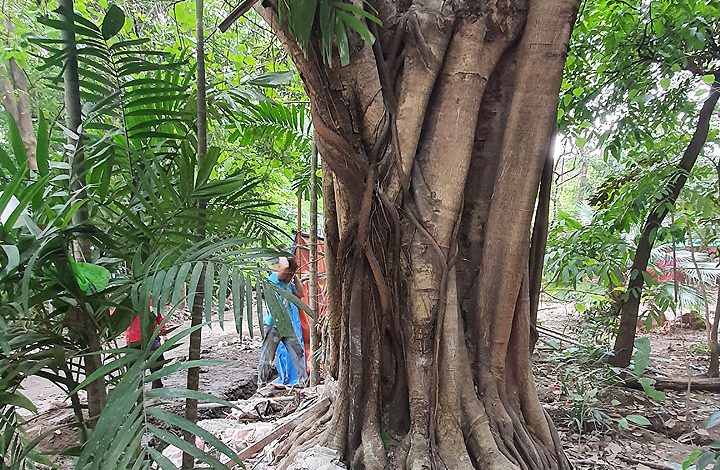Nature is jilted by untrue lovers

Why have the birds stopped singing and flown away from the Arroceros Forest Park?
The Haribon Society and the Wild Bird Club have seen and identified some 30 or so species of migratory birds resting or living in the mini-forest. They chirped and warbled under the darkened canopy of 3,500 endemic or native trees — including 150 centuries-old survivors of World War II, and more trees that are at least 30 years old and older — at the Arroceros Forest Park. Fragile seedlings and younger trees of a diverse variety grow undisturbed, such as the acacia, agoho, anahaw, banyan, kamagong, mahogany, molave and narra, among others.
The Arroceros Park is a natural forest, where the ground cover of small plants keeps the soil moist and rich with the natural compost of fallen leaves and broken twigs. Like a womb, the forest provides natural incubation for life and growth. Between the latticed canopy of the older trees and the speckled ground vibrates the chi of virgin Nature, cooled by the gentle breath of the Pasig River that flows alongside the 2.2 hectare protected forest.
In a study on Manila’s urban green spaces conducted in 2016, Arroceros was found to have the highest proportion of crown canopy cover among the other parks in Manila’s fifth electoral district. It also has one of the highest rates of vegetation, one of the parameters of resiliency that “improves infiltration, reduces surface run off, prevents siltation and ultimately, reduce exposure to flooding,” the study says (https://www.sciencedirect.com). Arroceros’ high coverage of crown canopy also helps in regulating the city’s temperatures, which can sometimes reach as high as 38 degrees Celsius /100 degrees Fahrenheit (https://news.mongabay.com).
“The last lung of Manila” is the only natural park of the city, encapsulated against the heavy pollution of vehicle traffic in the city of about 1.85 million people. The 2019 average pollution index for Metro Manila was 18.2 US AQI (air quality index) which placed it as the 5th most polluted city in all of the Philippines. The World Health Organization (WHO) reported that the safe level of air quality ranged from 10 ug per cubic meter of PM2.5, or below. The WHO said that in 2018, there were 45.3 air pollution-related deaths for every 100,000 people in the Philippines. This was the third highest in the world, after China’s 81.5 pollution-related deaths and Mongolia’s 48.8 deaths per 100,000 people. The United States Environmental Protection Agency (EPA) in 2016 stressed that “Arroceros Forest Park … can remove 30 tons of particulates per year. It provides a ‘Lung’ for the city.”
The Arroceros Forest Park should be one of the most treasured and protected nature sanctuaries, and it is a historic icon — once the first of three “parians” that contained and suppressed the local Chinese community since the rebellion of Chinese traders in the early Spanish colonial period in the 19th century. The Parian de Arroceros served as a marketplace and trading post for Chinese merchants. Among the commodities traded back then was rice, hence the term arroceros, which means “rice cultivators” in Spanish.
The space vacated by the parian had been used as temporary “holding area” for odds-and-ends of government activities both in the Spanish era and in the American occupation, through World War II. Only after the government’s education department offices, erstwhile “parked” in the area, were transferred to their present location in Pasig in 1993, was the Arroceros Forest Park concept formalized. A memorandum of agreement was signed between the City of Manila and Winner Foundation, a proactive private environment group, to work with the Manila Seedling Bank and manage reforestation efforts to resuscitate and nurture “the Last Lung of Manila” (The Philippine Star, retrieved June 10, 2015).
Did many give much importance to the Arroceros Forest Park as it grew and bloomed into a solitary environment sanctuary in the heart of polluted Manila? Sadly, the stream of elected Manila City mayors did not really respect the forest park (except Mayor Alfredo Lim, who gave Winner Foundation free sway in managing the reforestation). And few common citizens come to visit and enjoy the forest park. There seems to be no deep passion for the environment. Sad.
“Yet, despite the respite the park offers its avian and human visitors, Manila’s mayors have persistently insisted on getting rid of it. Lito Atienza, who served as mayor from 1998 to 2007, allowed a portion of the park to be bulldozed for a new government building, while Joseph ‘Erap’ Estrada, a former president and mayor from 2013, wanted to turn the park into a school gymnasium.” (https://news.mongabay.com/2019/09/).
Enter Mayor (Yorme) “Isko” Moreno (Francisco Domagoso) after winning over his long-time idol, Mayor Erap, in the 2019 mayoralty elections. Bringing with him his matinee-idol lover boy image in local young-love movies of the 1990s, young and old swooned to romantic hero-worship for what he promised to do for Manila. A big come-on, aside from his good looks and supposed “clean” image is that he was born and raised in the slums of Tondo, Manila, where he spent his childhood supporting his family by scrapping for leftover food and scavenging the trash heaps of “Smokey Mountain.” Surely, Isko would be a passionate lover and protector of the environment.
And so, Winner Foundation and cooperator Manila Doctors Hospital CSR (Corporate Social Responsibility) staff met with Isko upon his assumption as Mayor, to plead for the final and official cancellation of former Mayor Erap’s pending project to raze a big portion of the forest park to set up a full-service gym. And Isko signed on Feb. 27, 2020 Manila City Ordinance No. 8607, declaring the land along Arroceros Street as a “permanent forest park” from simply being a “property” (Rappler, March 3, 2020).
“The use and enjoyment of the Arroceros Forest Park must be consistent with the principles of sustainable development and the right of the people to a balanced and healthful ecology,” the ordinance reads.
The ordinance prohibits the cutting trees, the dumping waste, and any form of excavation in the area. Violators will be slapped with a P2,500 fine for the first offense, P3,500 for the second offense, and P5,000 fine and/or imprisonment up to one year, depending on the court’s discretion, for their third offense. (Ibid.).
But when Regina “Ninit” Roces-Paterno, chair of Winner Foundation, and Chiqui Sy-Quia Mabanta, president, with other environment activists visited the Arroceros Forest Park on Nov. 13, 2021, it was a shock that Mayor Isko was already implementing his September 2021 development plan for the Lawton area, the vicinity of the Arroceros Forest Park. Construction was not supposed to encroach into the nature park but confined only to outside of its perimeter.
Paterno sent this message on Viber:
“I am so sad to report to the Catholic Women’s Club that the City of Manila administration under Isko Moreno has all but ruined the forest in the course of their desire to turn it into a theme park with stairways and elevated walk ways. The CWC area is all but destroyed with two structures being constructed in the front area. In our second project by the bridge, they covered the fishpond and it is used for dumping construction materials and debris.
“I was with a group of environmental organizations and we were all filled with shock and disgust over a complete disregard for environmental laws.
“We hope that it is not too late to halt what is going on. They have hundreds of men working fast and filling the area with concreted grounds and pathways.
“Five natural ponds were filled up with soil and all secondary trees and ground cover were destroyed in their desire to make it look like Luneta. They should have chosen another area because this forest took almost 30 years to grow not counting the 150 pre-war trees. Winner Foundation planted 3,000 trees from Manila seedling bank. And eventually CWC planted more than 100 trees not to mention supported the maintenance of two workers for several years.”
“A sad day for enviromentalists!” Paterno said.
Nature is again jilted by untrue lovers.
Amelia H. C. Ylagan is a doctor of Business Administration from the University of the Philippines.




